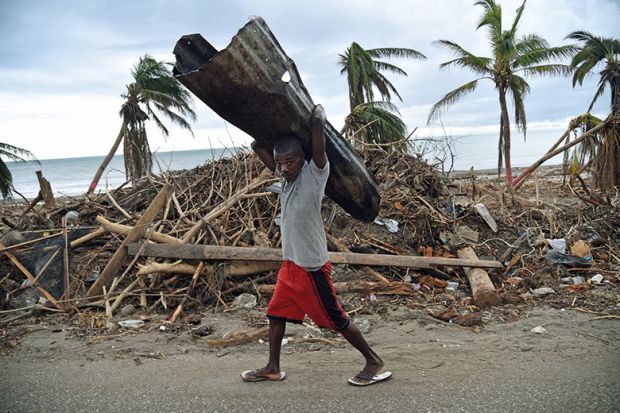The impact of major disasters – whether natural or man-made – on the world’s poorest countries is something never far from global news headlines.
However, according to a new report looking in detail at disaster science around the globe, there is a “disconnect” between where the impact of such catastrophes is most keenly felt and where most scholarly research into the topic is being carried out.
Furthermore, according to the study by Elsevier, this could be seriously skewing what topics are studied and possibly failing to address the particular needs of the developing world.
A Global Outlook on Disaster Science – which uses as its basis the United Nations "Sendai" framework adopted in 2015 on reducing the impact of disasters – looks at the data on around 27,300 disaster science papers published from 2012 to 2016 to show that the source of scholarship is more closely linked to the economic impact of disasters on a nation than the death toll they are responsible for.
Although it may not be surprising that richer countries can afford to conduct more research on disasters, the report says this “poses the question of whether there are aspects of disaster science that are particularly relevant to emerging countries with a high disaster burden, and whether these are currently under-researched”.
A key case study in the developed world is Japan, which is three times more specialised in disaster science than the world average (publishing more than 4,000 pieces of research in the area from 2012 to 2016) and with a citation impact that is higher than the norm for the field. However – perhaps understandably given the impact of earthquakes on the country – a significant slice of its research focuses on geophysical disasters. This skews world disaster science: geophysical disasters are by far the most heavily researched globally.
At the same time, some of the countries that suffer the biggest impacts from disasters have virtually non-existent research: Haiti has the highest death toll from disasters relative to its population but only produced 42 publications in disaster science in the five-year period studied.
It might hardly be expected that a country like Haiti would have the research infrastructure to be able to produce more scholarship, but experts in disaster science said it highlighted the need for researchers in developed nations to do more to help.
“It is crucial to strengthen the collaboration between researchers, practitioners, and policymakers, to understand local needs, and to conduct collaborative research with countries that are particularly vulnerable to disaster risks,” says Takako Izumi, associate professor at the International Research Institute of Disaster Science in Japan’s Tohoku University, in the report.
Rosanna Smith, deputy director of the UCL Institute for Risk and Disaster Reduction, said researchers in developed countries that did not suffer so much from natural disasters – like the UK – were sometimes better placed to be more international and outward looking than a nation with major disasters on its doorstep, such as Japan.
However, even in the UK there may be a tendency – especially in terms of understanding the science of disasters – to work more prominently with universities in other developed countries.
“Pragmatically, you can gain a better understanding by looking at things in a country that already monitors things very closely and where data collection is more readily available and possible,” she pointed out.
This is backed up by the report: although looking at international collaboration in detail was “beyond [its] scope”, it does point out that “collaborations between the…most research-intensive nations in disaster science (China, US, Japan, and the UK) [are] to a large extent bilateral rather than multilateral”.
For instance, in some European countries a topic that features prominently is research into chemical and radiological disasters, possibly due to their use of nuclear power and the desire to learn lessons from events like the accident at the Fukushima nuclear plant in Japan in 2011 (itself caused by a tsunami).
But exactly how can more research in developed countries be encouraged to focus on disasters that predominantly affect poorer nations?
One possible model currently in its early stages in the UK is the government’s Global Challenges Research Fund, a £1.5 billion funding stream allocated by the country’s research councils for projects tackling problems in developing countries.
Although the fund has had its critics, due to it tying a major element of overall UK research funding to a stream that also forms part of the UK’s foreign aid budget, it could boost research into disasters in the developing world.
Dr Smith said that although it was still too soon to assess its full impact, it had the potential to be important for disaster science as some of the money could go directly to developing countries “to really build their capacity to do their own research on their own local disasters but with the support of these top British institutions and academics”.
“It is early days…but overall it seems to me quite an exciting research initiative for British universities to get involved in. I think a lot of people are very motivated when such types of research fund comes because it feels like a real way for your research to make quite a difference.”
Rajib Shaw, a professor in the Graduate School of Media and Governance at Keio University in Japan, and an adviser to the UN’s International Strategy for Disaster Reduction (ISDR), said it would take time to create the kind of “in-built research grant system” that some high-risk developing countries needed.
He said the ISDR’s advisory group for science in Asia was trying to develop more cooperation between developing nations “as well as encouraging the national governments to start research funding schemes within the countries”.
Professor Shaw added that “private sector involvement in the high-risk countries can possibly [bring in] new resources” so researchers sometimes needed “to change their traditional mindset to come out of the ‘comfort zone’” to raise money from other sources for their work.
Anders Karlsson, vice-president for global strategic networks at Elsevier, said he hoped the report would help put the “spotlight” on disaster science, not least because it showed its overall share of world research was just 0.22 per cent. It also found that there was a much lower volume of research into disaster recovery (just 13 per cent of all disaster science papers), another aspect that arguably might be more helpful to developing nations.
However, Dr Karlsson said the report also found that current work “is increasingly focusing on disaster prevention and preparedness”, which was in line with goals in the UN’s Sendai framework on reducing disasters risk.
“Furthermore, [the] responsiveness of research in disaster science should be highlighted – academic research is quick to analyse recent disasters providing an opportunity to learn from each event in a forensic way.”
Find out more about THE DataPoints
THE DataPoints is designed with the forward-looking and growth-minded institution in view




